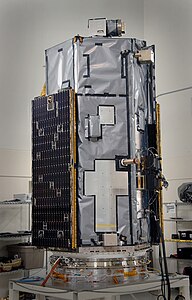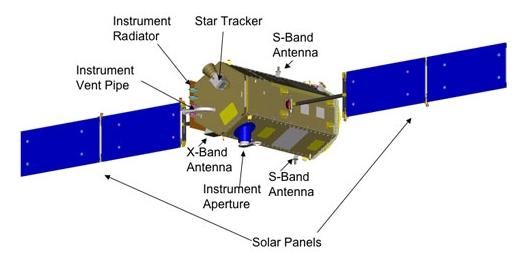Orbiting Carbon Observatory
| Orbiting Carbon Observatory (OCO) | |
|---|---|

|
|
| Type: | Research satellite |
| Country: |
|
| Operator: |
|
| COSPAR-ID : | - |
| Mission dates | |
| Dimensions: | 530 kg |
| Begin: | February 24, 2009, 9:55 UTC |
| Starting place: | Vandenberg AFB LC-576 |
| Launcher: | Taurus-3110 |
| Status: | burned up on February 24, 2009 |
| Orbit data | |
Orbiting Carbon Observatory (OCO) was the name of a NASA research satellite from the Earth System Science Pathfinder (ESSP) program to collect data on the Earth's carbon dioxide levels .
The $ 273 million (equivalent to 213 million euros) and 530 kg heavy satellite was launched on February 24, 2009 with a Taurus-XL rocket at 9:55 a.m. UTC from Vandenberg Air Force Base, launch site 576-E in the US The state of California was launched and was to be placed in a 700 km high orbit, which was not reached due to an error when detaching the payload fairing shortly after the ignition of the third drive stage. Because of the additional weight, the thrust of the other stages was insufficient to achieve the necessary speed, so that the rocket with the payload re-entered the atmosphere near Antarctica and crashed into the sea. The US space agency NASA spoke of a "serious disappointment for science".
construction
For the measurements, OCO had a high-resolution three - channel spectrometer , which was supposed to measure the absorption of carbon dioxide and molecular oxygen in the infrared range of the sunlight reflected by the earth's atmosphere. Twelve measurements per second with a resolution of three square kilometers should be made on the ground. For the three-axis stabilized attitude control , the satellite had u. a. via a star sensor and four reaction wheels . To track control were a GPS receiver and four hydrazine -Triebwerke installed. Two S-band antennas for receiving commands and an X-band antenna for transmitting telemetry and measurement data to earth should be used for communication with the ground.
OCO 2
In February 2013 NASA planned to launch an identical replica of the crashed OCO under the name OCO 2 with the same version of the Taurus rocket as the first copy. After the false start of the Glory satellite with the next Taurus 3110 because the payload fairing could not be thrown off again, NASA canceled the launch contract. The planned start date was postponed to July 2, 2014 due to the new tendering.
See also
Web links
- NASA / JPL: OCO project website (English)
- NASA: Orbiting Carbon Observatory (English)
- Gunter's Space Page: OCO 1, 2 (ESSP 5) (English)
Individual evidence
- ↑ http://www.spaceflightnow.com/tracking/launchlog.html
- ↑ Satellite launch failed . In: Schwäbische Zeitung from February 25, 2009
- ^ Spaceflight Now: NASA environmental satellite lost in launch failure
- ↑ Satellite falls into the water . In: Südkurier from February 25, 2009
- ↑ Spaceflight Now: NASA gives Taurus another chance to launch OCO craft
- ↑ Stephen Clark: Carbon-sniffing satellite faces one-year delay. Spaceflight Now, February 10, 2012, accessed February 12, 2012 .
- ^ William Graham: ULA Delta II successfully lofts OCO-2 to orbit. nasaspaceflight.com, July 2, 2014, accessed December 16, 2015 .



